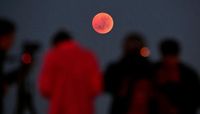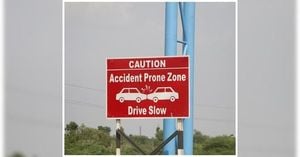Stargazers around the world are preparing for a celestial event that promises both spectacle and science: on the night of September 7-8, 2025, a total lunar eclipse—popularly known as a "blood moon"—will grace the skies above much of the Eastern Hemisphere. For those lucky enough to be in the right place at the right time, the moon will slip into Earth's shadow, transforming from its usual silvery white to a deep, mesmerizing red.
According to Time and Date and NASA, this total lunar eclipse will be visible across Europe, Africa, Asia, Australia, eastern Australia, New Zealand, and parts of the Middle East. North America, including states like Arizona and Iowa, will miss the main event due to the timing—daylight hours will prevent direct observation. However, the event will be livestreamed for those eager to witness the spectacle from afar.
The September full moon, known interchangeably as the "harvest moon" or "corn moon" (the latter a nod to the harvest season and a leading commodity in Iowa, as noted by the Des Moines Register), will reach its peak on the evening of September 7. For sky-watchers, the moon will appear full not only on that night but also the day before and after, offering a weekend-long lunar showcase. As CNN reports, "full moons appear round to the naked eye one day before and after their peak," giving observers a generous window to enjoy the view.
The main event begins at 9:27 a.m. Arizona time (11:28 a.m. Eastern Time) on September 7, 2025. The maximum eclipse, when the moon is fully immersed in Earth’s shadow, is slated for 11:11 a.m. Arizona time (1:30 p.m. Eastern Time), with the entire eclipse stretching over 5 hours and 27 minutes, and totality lasting for 1 hour and 22 minutes, according to Time and Date and EarthSky. While North and South America will be left out of the direct view, those in the Eastern Hemisphere are in for a treat.
But what exactly is a total lunar eclipse? As Space.com and NASA explain, a total lunar eclipse occurs when the sun, Earth, and moon align perfectly, with Earth positioned between the other two. Earth’s shadow falls upon the moon, dimming its surface and causing it to take on a striking red hue. This happens because Earth's atmosphere scatters blue and green light but allows red and orange wavelengths to pass through and reflect onto the lunar surface. The result is the iconic "blood moon"—a phenomenon that, while not especially rare on a global scale, is always awe-inspiring.
"The beauty of a lunar eclipse is that it’s gradual. For folks that have seen solar eclipses, they happen fairly rapidly. The lunar eclipse is a far more relaxed environment," said Noah Petro, chief of NASA’s Planetary Geology, Geophysics and Geochemistry Lab at Goddard Space Flight Center, in an interview with CNN. He added, "You don’t have to be in a specific spot (to see it), but you have to be in the right hemisphere."
During totality, the moon glows red-orange, illuminated by sunlight filtered through all the sunrises and sunsets happening on Earth at that moment. Sara Russell, research scientist and head of the Planetary Materials Group at London’s Natural History Museum, told CNN, "A lunar eclipse is a truly incredible sight, and something you can see without any special equipment—you do not need a telescope or even the special eclipse glasses that you need for a solar eclipse." Still, she noted that binoculars or a telescope can enhance the experience, revealing subtle details and colors.
Occasionally, just before and after totality, the moon may display a blue or purple band of light—a phenomenon caused by sunlight passing through Earth’s ozone layer, Russell explained. For those who love the science behind the spectacle, these fleeting colors offer another layer of wonder.
For those in North America, the timing of the eclipse means the moon will be below the horizon during the event. As the Des Moines Register points out, "Iowans and the rest of North America will not be able to witness the lunar eclipse because it will occur during the day. Meaning only those in eastern Australia, New Zealand, Africa and parts of the Middle East will see the September lunar eclipse." Nonetheless, the full moon will still be visible, weather permitting, and forecasts for places like Des Moines predict mostly clear skies and a crisp low of 44 degrees Fahrenheit on September 7.
While lunar eclipses are not as rare as solar eclipses—typically occurring about every two to three years—catching one from a specific location can be a matter of luck and timing. As NASA and Space.com note, solar eclipses are generally less frequent for any one location, while lunar eclipses can be seen by a much wider swath of the globe. The last lunar eclipse before this one occurred in March 2025, and the next total lunar eclipse visible in North and South America will not occur until March 3, 2026, according to CNN and NASA.
Even for those who miss the eclipse, there is still plenty to look forward to in the night sky. The next three full moons after September—occurring on October 6 (harvest moon), November 5 (beaver moon), and December 4 (cold moon)—will all be supermoons, appearing larger and brighter than usual as the moon passes closest to Earth in its orbit. Additionally, a partial solar eclipse will be visible in parts of Australia, the Atlantic, the Pacific, and Antarctica just two weeks after the lunar eclipse, on September 21. Meteor showers, including the Draconids and Geminids, will also provide sky-gazers with ample opportunities for wonder in the coming months, as outlined by EarthSky and the American Meteor Society.
For those eager to catch a glimpse of the September 2025 lunar eclipse, experts recommend finding a spot away from city lights for the best view. As Sara Russell put it, "The Moon formed in the very earliest times of the Earth’s history, and the Earth and Moon have been through a lot together. You can see the evidence of that with the naked eye, looking up to see all the craters on the Moon that have been formed over 4.5 billion years of history." Whether you see the blood moon in person or online, it's a reminder of our planet's place in the cosmos—and the enduring allure of the night sky.




